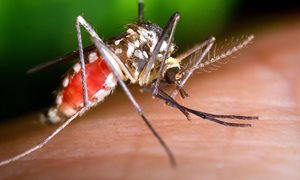
The door has finally opened on screening newborn babies for pyridoxine-dependent epilepsy (PDE), a severe inherited metabolic disorder. This screening promises to enable better and earlier treatment of the disease. To identify new biomarkers that can be used in the newborn screening protocol, also known as the neonatal heel prick, researchers at the Radboud University Medical Center joined forces with scientists at the Radboud University’s HFML-FELIX laboratory. They published their findings in The Journal of Clinical Investigation.
The discovery and identification of the new biomarkers could lead to an important addition to worldwide newborn screening protocols. Currently, there are over a thousand known inborn metabolic diseases (IMD), but only 2% of them can be detected through the neonatal heel prick. While these are relatively rare as individual disorders, in the Netherlands, every other day a child is born with an IMD. These disorders have severe health consequences for patients and are currently one of the leading causes of early death among children in the Netherlands.
Technologies combined
“Using new techniques in our clinical laboratory where we study the products of chemical processes (metabolomics), we were able to detect the presence of compounds in body fluids of patients that are not present in persons unaffected by PDE – that was a great first step. However, we could only identify the exact structure of these compounds, the new PDE biomarkers, using the infrared laser at FELIX”, says Karlien Coene, laboratory specialist and researcher at the Translational Metabolic Laboratory of the Radboud University Medical Center. This is the first time that an infrared free electron laser – of which are only a hand full in the world – is combined with these clinical experiments.
Pyridoxine-dependent epilepsy (PDE) is an inherited metabolic disorder that is primarily characterized by intractable seizures that do not respond to conventional antiepileptic medications. Seizures are often controlled by daily high doses of vitamin B6, however 80% of affected children nevertheless suffer developmental delay and intellectual disability.
Early screening for metabolic diseases is critical for optimal treatment. That is why researchers are constantly looking for new ways to detect more metabolic diseases earlier in life via the heel prick. These diseases can be identified by looking for the presence of small molecules in the blood that are unique to the disease, also called “biomarkers”.
Circumvent bottlenecks
Biomarker discovery and identification is a well-known bottleneck in research of metabolic diseases. “To overcome this hurdle, we decided to combine the advanced analytical instrumentation with the infrared laser of the FELIX laboratory’, says Jonathan Martens, researcher at Radboud University’s FELIX Laboratory. “The measurements obtained using the unique FELIX laser gives us information about the bonds between the atoms and leads us to the precise molecular structure. With this information, we ultimately managed to synthesize the molecules and this allowed us to further investigate their role in the disease.”
In addition to new possibilities in newborn screening, this finding has also revealed fundamental insights about the disease, which could ultimately lead to optimized treatment and better chances to prevent cognitive disability.
Martens: “Now that we have demonstrated that this new combination of techniques really works, we are actively applying our method in research on a range of other (metabolic) diseases for which biomarkers are currently lacking.”
-
Want to know more about these subjects? Click on the buttons below for more news.
Related news items

The future of laboratory animal research More attention to living conditions of laboratory animals
16 May 2022 On May 9, a meeting took place at the Radboudumc as a result of the launch of the Dutch Transparency Agreement on Animal Testing. The Radboudumc is one of the twenty signatories and has thus committed itself to openly and transparently communicate its vision and policy with regard to animal testing. read more
Arnhem Nijmegen: top region in Health, High-Tech and Energy
10 February 2022 Projects in the Arnhem Nijmegen region can expect millions of extra euros in the coming years. This will be used for, amongst other things, the circular economy and pioneering applications in the fields of Health, High-tech and Energy. read more
Nijmegen literally puts Digital Health on the map Flourishing ecosystem gets its own interactive overview
22 July 2021 Digital Health is thriving in the Nijmegen region, where it contributes to better care and health and also creates jobs. To bring developers and end users even closer together, The Economic Board and the Radboudumc are introducing the Interactive Digital Health map. read more
Sonlicromanol seems promising for certain cancers Khondrion announces publication in PLOS ONE of new research
13 July 2021 Khondrion announces publication in PLOS ONE of new research showing normalisation of prostate cancer stem cell mPGES-1 overexpression and inhibition of cancer spheroid growth by sonlicromanol’s active metabolite. read more
First volunteers vaccinated with Radboudumc malaria vaccine
20 May 2021 Today a new vaccine against malaria, largely developed in Nijmegen, is being tested for the first time in volunteers at Radboudumc. read more
Vici grant for Michiel Vermeulen Reading the epitranscriptome
15 April 2021Michiel Vermeulen, theme Cancer development and immune defense, has been awarded a Vici grant from the Netherlands Organisation for Scientific Research (NWO), one of the largest personal scientific awards in the Netherlands.
read more